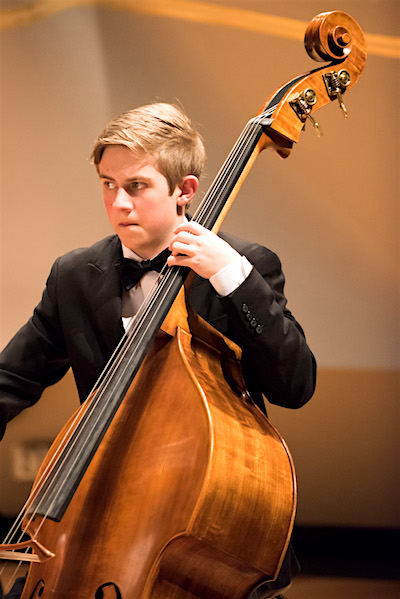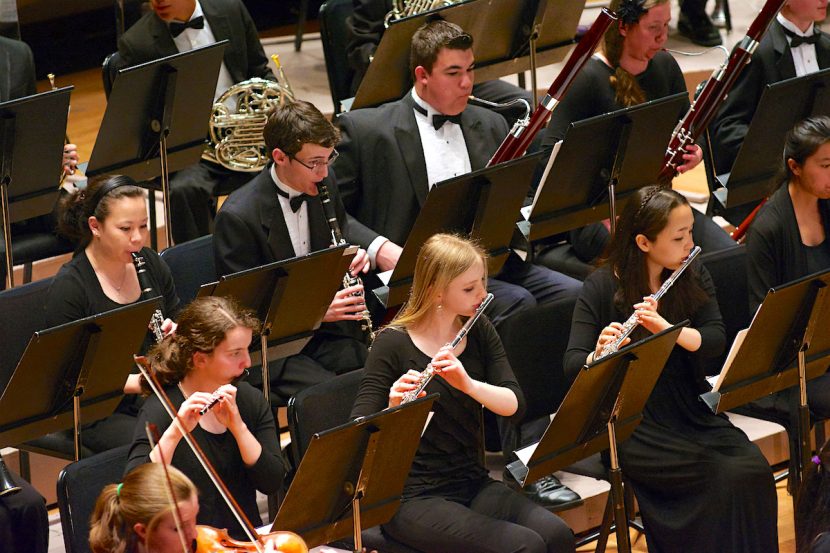by Marcus Turner
Playing music in a youth orchestra offers a host of opportunities, from performing to meeting peers who are equally as passionate about music, to preparing for auditions. Let’s take a closer look at how youth orchestras are set up and how they can help you if you’re a serious musician interested in possibly majoring in music.
Just the facts, ma’am
When considering a youth orchestra, you’ll want to first be sure you have all of your facts straight. For instance, does your instrument fit into the orchestra?
Most youth orchestra programs accept all standard orchestral instruments (violin, viola, cello, double bass, harp, flute, oboe, clarinet, bassoon, trumpet, French horn, trombone, tuba, percussion). While some orchestral repertoire uses saxophone, standard orchestras do not have a permanent saxophonist (though other opportunities exist in extracurricular wind ensembles where saxophones are needed).
Other things to consider include private lessons, which are often required to join a youth orchestra.
Your first audition!
Membership in a youth orchestra is typically based on an audition. This gives the conductor the opportunity to hear each member of the ensemble before deciding on the pieces the group will perform.
There are often a variety of orchestras available for students as they develop musically. For example, the Greater Boulder Youth Orchestra in Boulder, Colorado consists of three orchestras and one wind ensemble. Executive Director Brian Jack says, “For many of our youngest members, they’re about to complete Suzuki Book 2 and this is their first orchestra experience.”
Regardless of your age and playing level, your audition and the opportunity to receive feedback are invaluable as you decide whether music is the career path for you.
Upping the bar
As musicians develop technically, their ability to play more advanced music develops as well. Advanced youth orchestras offer students the opportunity to experience masterworks by composers such as Beethoven, Brahms and even Mahler. These experiences can be a wonderful complement to the education you receive through your school band or orchestra program and prepare you for an intensive musical education. In fact, according to Julie Strom, orchestra manager for the Denver Young Artists Orchestra, “Approximately 75% of graduated students move on to major or minor in music in college.” The chance to be around other students who share a passion for music-making often leads to lifelong friendships and connections for youth orchestra members as well.
Costs
While the positive experiences that students gain from youth orchestra membership are vast, parents and families often wonder about the costs involved. More and more youth orchestras have begun to incorporate accessibility into their planning to encourage more students to participate. The Youth Orchestras of Fresno, a program based on the El Sistema Model, run an “Accent on Access” program designed to offer students free after-school violin lessons. Many of these students end up joining the youth orchestras after developing their skills. In addition to programs like these, youth orchestras often offer “need-based” scholarships to assist families with the cost of participation.
Putting in the hours
Being a member of a youth orchestra, as with any team or club, involves a significant time commitment. If you are taking private lessons, playing in your school band or orchestra, and participating in a youth orchestra, you may find that your practice time needs to be increased to keep up. Additionally, rehearsals may take place on weekends or evenings when all students are usually available. Missing even one rehearsal can have a major impact on the success of the orchestra.
 While this may seem overwhelming, the experience can be viewed as preparation for college, where deadlines, finals, papers and practice all must go together in harmony. “Regardless of their college majors,” says Brian Jack of the Greater Boulder Youth Orchestra, “all students can benefit from the skills used in youth orchestra, including teamwork, concentration, prioritization, practice, and much more.”
While this may seem overwhelming, the experience can be viewed as preparation for college, where deadlines, finals, papers and practice all must go together in harmony. “Regardless of their college majors,” says Brian Jack of the Greater Boulder Youth Orchestra, “all students can benefit from the skills used in youth orchestra, including teamwork, concentration, prioritization, practice, and much more.”
Outside the (conductor’s) box
While youth orchestras can perform standard orchestral repertoire, these organizations may also run special programs. The Chicago Youth Symphony, in addition to its large orchestras, offers a jazz orchestra and steel pan orchestra. The South Bend Youth Symphony includes a special chamber music program that brings students out into the community performing small concerts at bookstores, nursing homes and restaurants.
Key points
Youth orchestras create a community in which musically-inclined students can thrive. Regardless of whether you go on to study music, chemistry or engineering, a youth symphony experience can be a positive guiding force in socialization and development.
If you are considering joining a youth orchestra, here are some questions to ask:
• Do they take my instrument? If not, is there another program I could join that does take my instrument?
• When are rehearsals? Can I fit them into my schedule?
• What does the audition entail? When are auditions held?
• What is the cost of tuition? Are scholarships available?
Once you have answers to these questions and are ready to move forward, you will join a community unlike any other and take one more step in preparing to major in music if that’s your goal.
Musician and administrator Marcus Turner has worked with the Denver Young Artists Orchestra, University of Denver and University of Colorado Boulder College of Music. He holds degrees in Music Education and Musicology from VanderCook College of Music and the University of Colorado Boulder College of Music.
Photo credits:
Courtesy of Denver Young Artists Orchestra, photography by Doug Zimmerman.



Leave a Reply